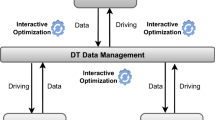Abstract
For heterogeneous scientific and technical knowledge organization systems (HSTKOSs), computer-aided concept mapping discovery becomes very difficult among HSTKOSs. First, this paper puts forward and establishes a common data model (CDM) oriented to the HSTKOS used for the standardized description of scientific and technological knowledge concepts. Then, in the mapping discovery algorithm, the algorithms to discover the relations of inheritance, “is a characteristic of”, “is a part of”, relevance and other partial ordering relations between heterogeneous concepts are put forward and designed through mapping transfer. Finally, the empirical results show that in public concept space, the mapping discovery algorithm, put forward and designed by this paper, is feasible and can have certain practical significance.







Similar content being viewed by others
References
Adali, S., Emery, R.: A uniform framework for integrating knowledge in heterogeneous knowledge systems. In: IEEE Proceedings of the Eleventh International Conference on Data Engineering, pp. 513–520 (1995)
Teraoka, T.: Organization and exploration of heterogeneous personal data collected in daily life. Hum.-Cent. Comput. Inf. Sci. 2(1), 1–15 (2012)
Gruber, T.R.: A translation approach to portable ontology specifications. Technical Report of Knowledge System Laboratory, 513–520 (1993)
Wiederhold, G.: Mediators in the architecture of future information systems. Computer 25(3), 38–49 (1992)
Adali, S., Subrahmanian, V.S.: Amalgamating knowledge bases II: distributed mediators. Int. J. ntell. Coop. Inf. Syst. 3(04), 349–383 (1994)
Omid, M., Mohammad, R., Akbarzadeh, T.: A novel learning algorithm based on a multi-agent structure for solving multi-mode resource-constrained project scheduling problem. J. Converg. 4(1), 47–52 (2013)
Kim, B., Youn, C., Park, Y., Lee, Y., Choi, W.: An adaptive workflow scheduling scheme based on an estimated data processing rate for next generation sequencing in cloud computing. J. Inf. Process. Syst. 8(4), 555–566 (2012)
Yen, N.Y., Kuo, S.Y.: An integrated approach for Internet resources mining and searching. J. Converg. 3, 37–44 (2012)
Pan, R., Xu, G., Fu, B., Dolog, P., Wang, Z., Leginus, M.: Improving recommendations by the clustering of tag neighbours. J. Converg. 3(1) (2012)
Hsueh, H.Y., Chen, C.N., Huang, K.F.: Generating metadata from web documents: a systematic approach. Hum.-Cent. Comput. Inf. Sci. 3(1), 1–17 (2013)
Liang, A.C., Salokhe, G., Sini, M., Keizer, J.: Towards an infrastructure for semantic applications: methodologies for semantic integration of heterogeneous resources. Cat. Classif. Q. 43(3–4), 161–189 (2007)
Cilia, M., Antollini, M., Bornhovd, C., Buchmann, A.: Dealing with heterogeneous data in pub/sub systems. The concept-based approach, pp. 26–31 (2004)
Valencio, C.R., Oyama, F.T., Neto, P.S., Colombini, A.C., Cansian, A.M., de Souza, R.C.G., Correa, P.L.P.: MR-Radix: a multi-relational data mining algorithm. Hum.-Cent. Comput. Inf. Sci. 2(1), 1–17 (2012)
Kosovac, B., Froese, T., Vanier, D.: Integrating heterogeneous data representations in model-based AEC/FM systems. Constr. Inf. Technol. 2, 556–567 (2000)
Castano, S., De Antonellis, V.: Global viewing of heterogeneous data sources. IEEE Trans. Knowl. Data Eng. 13(2), 277–297 (2001)
Reddy, M.P., Prasad, B.E., Reddy, P.G., Gupta, A.: A methodology for integration of heterogeneous databases. IEEE Trans. Knowl. Data Eng. 6(6), 920–933 (1994)
Hudon, M.: Multilingual thesaurus construction: integrating the views of different cultures in one gateway to knowledge and concepts. Inf. Serv. Use 17(2–3), 111–123 (1997)
Leizeng, M., Maichan, L.: Trends and issues in establishing interoperability among knowledge organization systems. J. Am. Soc. Inf. Sci. Technol. 55(5), 377–395 (2004)
Whitehead, C.: Mapping LCSH into thesauri: the AAT model. In: Petersen, T., Molholt, P. (eds.) Beyond the Book: Extending MARC for Subject Access, p. 81. G.H. Hall, Boston (1990)
Mayr, P., Petras, V.: Cross-concordances: terminology mapping and its effectiveness for information retrieval. arXiv:0806.3765 (2008)
Chaplan, M.A.: Mapping “Laborline thesaurus” terms to Library of Congress subject headings: implications for vocabulary switching. Libr. Q. 65, 39–61 (1995)
Doerr, M.: Semantic problems of thesaurus mapping. J. Digit. Inf. 1(8) (2006)
Brahami, M., Atmani, B., Matta, N.: Dynamic knowledge mapping guided by data mining: application on healthcare. J. Inf. Process. Syst. 9(1), 1–30 (2013)
Nagpal, G., Uddin, M., Kaur, A.: A comparative study of estimation by analogy using data mining techniques. J. Inf. Process. Syst. 8(4), 621–652 (2012)
Wang, S., Englebienne, G., Schlobach, S.: Learning concept mappings from instance similarity. In: The Semantic Web-ISWC 2008, pp. 339–355. Springer, Heidelberg (2008)
Liping, Z., Guangyao, L., Yongquan, L., Jing, S.: Design of ontology mapping framework and improvement of similarity computation. J. Syst. Eng. Electron. 18(3), 641–645 (2007)
Farquhar, A., Fikes, R., Rice, J.: The Ontolingua server: a tool for collaborative ontology construction. Int. J. Hum.-Comput. Stud. 46(6), 707–727 (1997)
Czarnecki, K., Antkiewicz, M.: Mapping features to models: a template approach based on superimposed variants. In: Generative Programming and Component Engineering, pp. 422–437. Springer, Heidelberg (2005)
Gruber, T.: Collective knowledge systems: where the social web meets the semantic web. J. Web Semant. 6(1), 4–13 (2008)
Salton, G.: A vector space model for automatic indexing. Commun. ACM 18(11), 613–620 (1975)
Bringer, J., Chabanne, H.: Embedding edit distance to enable private keyword search. Hum.-Cent. Comput. Inf. Sci. 2(1), 1–12 (2012)
Acknowledgements
Support from the National Natural Science Foundation of China under Grant No 71271200 and National Twelfth “Five-Year Plan” for Science and Technology Support Program under Grant Nos 2011BAH10B04, 2011BAH10B02 are greatly acknowledged.
Author information
Authors and Affiliations
Corresponding author
Rights and permissions
About this article
Cite this article
Zhu, L., Shi, C. & Guo, J. Mapping discovery modeling and its empirical research for the scientific and technological knowledge concept in unified concept space. Cluster Comput 18, 103–112 (2015). https://doi.org/10.1007/s10586-013-0339-7
Received:
Revised:
Accepted:
Published:
Issue Date:
DOI: https://doi.org/10.1007/s10586-013-0339-7




